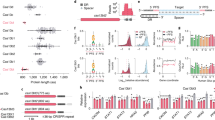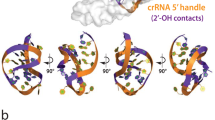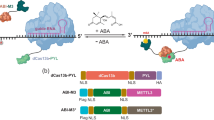Abstract
Molecular tools that target RNA at specific sites allow recoding of RNA information and processing. SNAP-tagged deaminases guided by a chemically stabilized guide RNA can edit targeted adenosine to inosine in several endogenous transcripts simultaneously, with high efficiency (up to 90%), high potency, sufficient editing duration, and high precision. We used adenosine deaminases acting on RNA (ADARs) fused to SNAP-tag for the efficient and concurrent editing of two disease-relevant signaling transcripts, KRAS and STAT1. We also demonstrate improved performance compared with that of the recently described Cas13b–ADAR.
This is a preview of subscription content, access via your institution
Access options
Access Nature and 54 other Nature Portfolio journals
Get Nature+, our best-value online-access subscription
$29.99 / 30 days
cancel any time
Subscribe to this journal
Receive 12 print issues and online access
$259.00 per year
only $21.58 per issue
Buy this article
- Purchase on Springer Link
- Instant access to full article PDF
Prices may be subject to local taxes which are calculated during checkout


Similar content being viewed by others
References
Frye, M., Jaffrey, S. R., Pan, T., Rechavi, G. & Suzuki, T. Nat. Rev. Genet. 17, 365–372 (2016).
Vogel, P., Schneider, M. F., Wettengel, J. & Stafforst, T. Angew. Chem. Int. Ed. Engl. 53, 6267–6271 (2014).
Stafforst, T. & Schneider, M. F. Angew. Chem. Int. Ed. Engl. 51, 11166–11169 (2012).
Nishikura, K. Nat. Rev. Mol. Cell Biol. 17, 83–96 (2016).
Rossi, A. et al. Nature 524, 230–233 (2015).
Vogel, P. & Stafforst, T. ChemMedChem 9, 2021–2025 (2014).
Montiel-Gonzalez, M. F., Vallecillo-Viejo, I., Yudowski, G. A. & Rosenthal, J. J. C. Proc. Natl. Acad. Sci. USA 110, 18285–18290 (2013).
Wettengel, J., Reautschnig, P., Geisler, S., Kahle, P. J. & Stafforst, T. Nucleic Acids Res. 45, 2797–2808 (2017).
Cox, D. B. T. et al. Science 358, 1019–1027 (2017).
Kuttan, A. & Bass, B. L. Proc. Natl. Acad. Sci. USA 109, E3295–E3304 (2012).
Eggington, J. M., Greene, T. & Bass, B. L. Nat. Commun. 2, 319 (2011).
Sinnamon, J. R. et al. Proc. Natl. Acad. Sci. USA 114, E9395–E9402 (2017).
Montiel-González, M. F., Vallecillo-Viejo, I. C. & Rosenthal, J. J. C. Nucleic Acids Res. 44, e157 (2016).
Fukuda, M. et al. Sci. Rep. 7, 41478 (2017).
Vallecillo-Viejo, I. C., Liscovitch-Brauer, N., Montiel-Gonzalez, M. F., Eisenberg, E. & Rosenthal, J. J. C. RNA Biol. 15, 104–114 (2018).
Ramaswami, G. & Li, J. B. Nucleic Acids Res. 42, D109–D113 (2014).
Bromberg, J. J. Clin. Invest. 109, 1139–1142 (2002).
Bennett, C. F., Baker, B. F., Pham, N., Swayze, E. & Geary, R. S. Annu. Rev. Pharmacol. Toxicol. 57, 81–105 (2017).
Hanswillemenke, A., Kuzdere, T., Vogel, P., Jékely, G. & Stafforst, T. J. Am. Chem. Soc. 137, 15875–15881 (2015).
Kim, D.-H. et al. Nat. Biotechnol. 23, 222–226 (2005).
Deffit, S. N. & Hundley, H. A. WIREs RNA 7, 113–127 (2016).
McMahon, A. C. et al. Cell 165, 742–753 (2016).
Ramaswami, G. et al. Nat. Methods 9, 579–581 (2012).
Ramaswami, G. et al. Nat. Methods 10, 128–132 (2013).
Li, H. & Durbin, R. Bioinformatics 26, 589–595 (2010).
Li, H. et al. Bioinformatics 25, 2078–2079 (2009).
McKenna, A. et al. Genome Res. 20, 1297–1303 (2010).
Kent, W. J. Genome Res. 12, 656–664 (2002).
Wang, K., Li, M. & Hakonarson, H. Nucleic Acids Res. 38, e164 (2010).
Acknowledgements
We gratefully acknowledge support from the Deutsche Forschungsgemeinschaft (STA 1053/3-2 and STA 1053/7-1 to T.S.), the European Research Council (ERC) under the European Union’s Horizon 2020 research and innovation program (grant agreement no. 647328 to T.S.), and the US National Institutes of Health (NIH) (grants R01GM102484 and R01GM124215 to J.B.L.).
Author information
Authors and Affiliations
Contributions
P.V., M.M., T.M., K.D.S., and T.S. conceived, performed, and analyzed the wet lab experiments; Q.L. and J.B.L. analyzed and all authors interpreted next-generation sequencing data; and all authors contributed to writing of the manuscript.
Corresponding author
Ethics declarations
Competing interests
The authors declare no competing interests.
Additional information
Publisher’s note: Springer Nature remains neutral with regard to jurisdictional claims in published maps and institutional affiliations.
Integrated supplementary information
Supplementary Figure 1 Site-directed RNA editing by SNAP-tagged ADARs driven by short, chemically modified guide RNAs.
a) General concept: The double-stranded RNA-binding domains (dsRBDs) of hADAR have been substituted with the SNAP-tag. The latter is able to form a covalent bond to a guideRNA that is modified with benzylguanine (BG). When bound to the SNAP-ADAR, the guideRNA steers the attached SNAP-ADAR protein to the target RNA and forms the necessary secondary structure for A-to-I editing catalyzed by the deaminase domain. b) A typical BG-guideRNA that targets a UAG site with a 5´-CCA anticodon. The guideRNA is 22-nt long and is densely chemically stabilized by 2’-methoxylation and terminal phosphorothioate linkages (commercially available). The first three 5’-terminal nucleotides do not base pair with the target RNA, but serve as a linker. The sequence comprises an unmodified ribonucleotide gap (5´-CCA) which faces the target site and contains a central mismatching cytosine opposite the targeted adenosine for efficient deamination. A commercial C6-amino-linker is located at the 5’-end of the guideRNA to introduce the BG modification to the full length oligonucleotide. Modification of the guideRNA with OSu-activated BG can be performed in any reaction tube. c) Experimental setup. Cells with stably integrated SNAP-ADAR (SA) are seeded into 24-well plates with medium containing doxycycline (dox) to induce SA expression. 24 h later, the cells were reverse-transfected with the guideRNA (see online Methods). After 24 h, the cells were lysed for RNA isolation to analyze RNA editing.
Supplementary Figure 2 Concurrent editing of three 5′-UAG sites in endogenous GAPDH transcript.
The respective SA‐expressing cells where transfected with either a single gRNA or 3 gRNAs against distinct sites on the endogenous GAPDH transcript. Data are shown as the mean±SD, N=3 independent experiments, black dots represent individual data points.
Supplementary Figure 3 Effect of global translation inhibition (puromycin) on RNA editing.
a) SA1 and SA2 cells were seeded on poly-d-lysine-coated glass slides. After one day, doxycycline (end concentration = 10 ng/ml) was added to induce SA enzyme expression. To inhibit translation, cells were additionally supplemented with 5 µg/ml puromycin, respectively. After 12h, cells were stained with BG-FITC and Hoechst. The staining shows that the applied amount of puromycin (5 µg/ml) is sufficient to block translation. The scale bar represents 40 µm. b) Cells were reverse transfected with BG-gRNA (5 pmol/96 well) targeting a UAG site either in the ORF (site #2) or in the 3’-UTR of GUSB. After 4 h, the cells were optionally incubated with 5 µg/ml puromycin for 12 h. Then, RNA was isolated and reverse transcribed for Sanger sequencing. As one can see, the editing levels differ between ORF and 3´-UTR in the absence of puromycin with less efficient editing in the ORF than in the 3´-UTR. After addition of puromycin translation is blocked (panel a) and the editing levels in the ORF increase to the levels obtained in the 3´-UTR (panel b), which don´t change notably under puromycin treatment. This supports our assumption that editing in the ORF can be kinetically limited by the process of translation. a), b) Two independent experiments were performed with similar results.
Supplementary Figure 4 Controlling off-target editing in SA1Q/SA2Q+ cells.
a) General strategy. To avoid unintended editing of an adjacent adenosine at the target site, the opposing base in the guideRNA can be modified by 2’-methoxylation (M) or 2’-fluorination (F). This is exemplary shown for the triplet CAA. b) In the study, off-target editing of an adjacent adenosine was detected in the triplets CAA, AAA, AAC and UAA when particularly using SA2Q cells. However, off-target editing was remarkably reduced when the strategy was applied. Data are shown as the mean±SD, N=3 independent experiments, black dots represent individual data points.
Supplementary Figure 5 Off-target editing and off-target codon preferences caused by SA enzymes.
a) Overall off-target sites are ranked by editing yields. b) Logo represents the sequence conservation around all significant off-target sites for SA1Q and SA2Q. c) Analysis of the codon changes for all off-target editings that were found in SA1Q and SA2Q cells. The ratio was calculated in relation to the total number of editing events happened in the coding region of the transcripts.
Supplementary Figure 6 Gene expression analysis.
FPKM values of approximately 25.000 expressed transcripts are compared between cells containing the empty pcDNA5 vector with SA1Q cells + gRNA (a) or SA2Q cells + gRNA (b). Plotted is the log2 fold change in expression against the FPKM of the respective transcript in the control cell line (pcDNA5). The left plots show the data for all transcripts, the right plots for the low expressing transcripts only (FPKM < 100). Analysis was restricted to transcripts with FPKM values ≥ 2 in either the control or the SNAP-ADAR-expressing cell line. No strongly expressed transcripts (FPKM > 100) show log2-fold changes >1. Log2-fold changes of low expressing genes originate from transcripts with low FPKM and very low read coverage (typically non-coding RNAs, read-coverage below 50). The significance of such expression changes are difficult to assess. Clearly visible was the different expression of SNAP-ADAR in the engineered versus control cell line as highlighted by light blue circles.
Supplementary Figure 7 Targeting of KRAS mRNA by SA1 and SA1Q.
The applied BG-gRNAs form 19 bp duplex structures with the target transcript. No off-target editing was detected within these mRNA/gRNA duplexes in KRAS mRNA. For further discussion, see also Supplementary Note 1. N=3 independent experiments were performed with similar results.
Supplementary Figure 8 Reanalysis of NGS data produced by Vallecillo-Viejo et al.15 according to our pipeline (Methods).
a) Number of transcripts covered in RNA sequencing of the samples with 2boxB-driven 4λN-ADAR2 enzymes. Shown are numbers of detected transcripts with a FPKM value ≥ 2. The dashed line shows the average of detected transcripts with FPKM value ≥ 2 produced in this study. b) Summary of off-target sites produced by 2boxB-driven 4λN-ADAR2 enzymes. Given are the numbers of off-target sites significantly differently edited compared to the related cells lacking editing enzyme and gRNA. NGS data were re-analyzed according to the protocol for detecting off-target editing by SNAP-ADAR enzymes (see online Methods). 1Nonsynonymous refers to editing that results in amino acid change (syn. = synonymous; nonsyn. = nonsynonymous); 2others refers to editing in introns, intergenic regions, and ncRNA.3Editings were carried out in 293T cells transfected with 4λN-ADAR2 enzyme, CFTR Y122X reporter and 2boxB-gRNA by Vallecillo-Viejo et al., RNA Biol. (2018). c) Ranking of all off-target editing sites by the editing level. Left panel: wildtype SA versus wt λN-ADAR; right panel: hyperactive SA versus hyperactive λN-ADAR. d) Like c) but ranking of all nonsynonymous off-target edits.
Supplementary Figure 9 Changes in editing efficiency and specificity upon variation of SNAP–ADAR induction time (0–48 h, as indicated).
a) The expression of SA1Q or SA2Q was varied and quantified by western blot analysis (shown in relative expression, asterisks (*) indicate unspecific protein bands). We assessed the effect of reduced SA expression levels on editing the on-target (GAPDH, ORF site #2) versus several high-ranked off-targets in SA1Q (b) and SA2Q cells (c). For SA1Q (b), we tested three top-ranked nonsynonymous off-targets (FN1, CCNI, LAMA1) and one top-ranked, known 3´-UTR editing site (RPS23). For SA2Q (c), we tested three top-ranked nonsynonymous off-targets (SSRP1, CCNI, LAMA1) and two top-ranked 3´-UTR editing sites (SSR2, RPS23). On-target editing tolerated the reduction of SA expression much better compared to most off-targets. At 4h induction (4-8% SNAP-ADAR protein expression compared to full induction after 48h), most off-target editing yields were reduced by 2- to 3-fold while the on-target editing was only reduced by 35% (SA1Q) and 25% (SA2Q) compared to the editing level at full induction (48h). a)-c) The data presented are obtained from a single experiment.
Supplementary Figure 10 Studying the Cas13b–ADAR repairV2 mutant (E488Q + T375G) in the context of the SNAP–ADAR system (SA2QG).
The respective double mutant (SA2QG) was genomically integrated into Flip-In cells analog as described for the other four enzymes (SA1, SA2, SA1Q, SA2Q). We then studied the editing of 6 different sites in the GAPDH transcript entirely analog as described. Interestingly, SA2QG was only active in the 3´-UTR. It was almost unable to edit targets in the ORF. SA2QG lagged behind the wildtype enzymes SA1 and SA2 in all studied codons. This is in contrast to Cox et al. (Ref. 10) who claim Cas13b-ADAR repairV2 to be a more specific mutant that still enables good editing yields. Editing levels between 5% and 10% are difficult to detect precisely by Sanger sequencing, editing levels below 5% (dotted line) cannot be detected. The data presented here is a single experiment (N = 1).
Supplementary Figure 11 Recruitment of various editases by Cas13–gRNAs (with and without DR domain).
Overexpressed Cas13-guideRNAs can also recruit human ADAR2 or SA2Q to elicit editing in co-transfected reporter transcripts to yields similar as Cas13b-ADAR repairV1 does. For further details and discussion, see Supplementary Note 2. Data are shown as the mean±SD, N=3 independent experiments, black dots represent individual data points. DR = Cas13 directing domain.
Supplementary Figure 12 Western blotting analysis of SNAP–ADAR expression.
Five Flip-In T-REx cell lines were generated expressing either the empty vector (pcDNA5) or SNAP-ADAR genes (SA1, SA2, SA1Q, SA2Q) under the control of a doxycycline-inducible CMV promoter. Western blot analysis was done after the cells were incubated with and without doxycycline for 1 day. A SNAP-tag antibody was used to evaluate the protein levels of the SNAP-ADAR enzymes. The expression of ß-actin served as reference. Asterisks (*) indicate unspecific protein bands. N = 2 independent experiments were performed with similar results.
Supplementary Figure 13 Editing control gDNA versus cDNA.
To ensure that editing occurred only at the transcript and not the genomic DNA (gDNA), sequencing traces of gDNA and cDNA derived from mRNA were compared after site-directed editing in the 3’-UTR of GAPDH. Only the cDNA traces showed an A-to-G change for SA1Q and SA2Q, indicating that both enzymes target only RNA but not DNA. N = 2 independent experiments were performed with similar results.
Supplementary Figure 14 Dose-dependence of editing when using a control gRNA lacking the benzylguanine (BG) moiety.
gRNA lacking the benzylguanine moiety was transfected in amounts of 0.625 pmol – 20 pmol, showing that efficient editing requires BG-dependent covalent bond formation via the SNAP-tag BG reaction. In particular, the wt enzymes SA1 and SA2 do not elicit editing. The hyper-active enzymes (SA1Q/SA2Q) require much higher doses to elicit editing when lacking the BG moiety. Data are shown as the mean±SD, N=3 independent experiments.
Supplementary Figure 15 gRNA-dependent off-target editing in GAPDH transcript outside the gRNA–mRNA duplex.
Different from the three other targets (ACTB, GUSB, SA), off-target editing was found in the GAPDH transcript when targeting the GAPDH transcript. These off-target sites are all outside the mRNA/guideRNA duplex. a) The GAPDH transcript was targeted with gRNAs at two sites in the ORF (#1, #2) and one site in the 3’UTR. Six off-target sites were observed (ORF 508/516/656/791 and 3’-UTR 135/150). b) Secondary structures of the off-target sites with strongest editing (ORF 791 and 3’-UTR 135) were predicted with mfold. 250 nt up- and downstream from the editing site were chosen for the analysis. The light blue circles highlight the off-target site. c) Editing of the respective six off-target sites in SA1Q cells transfected with the respective guideRNA(s) against the three target adenosines in the transcript. Off-target editing was promoted when the editase was directed into vicinity of the off-target site. d) The same observation was made for SA2Q cells, but with higher editing levels and different off-target preference. c), d) Data are shown as the mean±SD, N=3 independent, black dots represent individual data points.
Supplementary information
Supplementary Text and Figures
Supplementary Figs. 1–15, Supplementary Tables 1–4 and Supplementary Notes 1–4
Rights and permissions
About this article
Cite this article
Vogel, P., Moschref, M., Li, Q. et al. Efficient and precise editing of endogenous transcripts with SNAP-tagged ADARs. Nat Methods 15, 535–538 (2018). https://doi.org/10.1038/s41592-018-0017-z
Received:
Accepted:
Published:
Issue Date:
DOI: https://doi.org/10.1038/s41592-018-0017-z
This article is cited by
-
RNA editing enzymes: structure, biological functions and applications
Cell & Bioscience (2024)
-
Near-cognate tRNAs increase the efficiency and precision of pseudouridine-mediated readthrough of premature termination codons
Nature Biotechnology (2024)
-
Profiling the interactome of oligonucleotide drugs by proximity biotinylation
Nature Chemical Biology (2024)
-
DNA and RNA base editors can correct the majority of pathogenic single nucleotide variants
npj Genomic Medicine (2024)
-
CRISPR technologies for genome, epigenome and transcriptome editing
Nature Reviews Molecular Cell Biology (2024)



